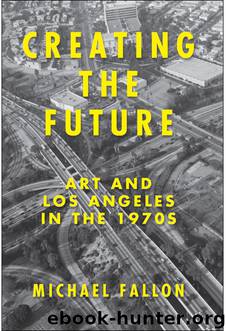Creating the Future by Michael Fallon

Author:Michael Fallon [Fallon; Michael]
Language: eng
Format: epub
ISBN: 9781619024045
Publisher: Counterpoint
OTHER SOCIALLY AND AESTHETICALLY INNOVATIVE and forward-thinking mural-type works complemented Asco’s rethinking of the mural form, and these proliferated around the streets of Los Angeles throughout the 1970s. For instance, the African American artist David Hammons, finding local avenues for his work slowed by speed bumps similar to those faced by Chicano and women artists, formed his own collective, called Studio Z, that met in his space on Slauson Avenue to explore a range of alternative media and formats of expression. Hammons had come to Los Angeles from Springfield, Illinois as a young man in 1963, studying first at Los Angeles City College before transferring to the Otis Art Institute and the Chouinard Art Institute, from which he graduated in 1968. Starting by making body prints similar to those of Yves Klein, in the 1970s Hammons’s production became more and more experimental, drawing influence from Dada, Art Povera, and the home-grown assemblage of artists like Ed Kienholz. In time, he developed a style that incorporated such eccentric elements as barbecue grease, chicken bones, rocks, empty wine bottles, and other found materials that connected him with his physical surroundings and were charged with racial identity.
Meanwhile, in collaboration with his shifting cast of cohorts at Studio Z—including Franklin Parker, Houston Conwill, Ulysses Jenkins, Maren Hassinger, and Senga Nengundi—Hammons also made work that was performance-based, highly political, and connected with the streets, walls, and public spaces of Los Angeles. “I think I spend 85 percent of my time on the streets as opposed to the studio,” he explained some years later. “So when I go to the studio I expect to regurgitate these experiences of the street. All of the things that I see socially—the social conditions of racism—come out like a sweat.”38 One important collaborative relationship that developed out of Studio Z was Hammons’s with Senga Nengundi. Born Sue Irons in Chicago, Nengundi came to Los Angeles with her mother when she was seven. While majoring in art and dance at Cal State Los Angeles in the late 1960s, she volunteered at the Watts Tower Art Center and learned about community-based art practices and the use of experimental art materials. Pantyhose, for instance, appeared in her work. Often transformed, filled, knotted, torn, and stretched to the limit, this unique material seemed, in Nengundi’s hands, to suggest certain feminist ideas—constriction, pain and violence, pregnancy, and the bodily presence of a woman. “Nengundi steals the prize for delight with her inventive series of installations of pantyhose,” wrote one critic of her work in the 1970s. “By stretching, filling parts with sand, and artfully tucking and pulling, she has created images which are at once tender, poignant, and funny reminders of the frailty of human form.”39
In March of 1978, these artists’ interests and the group energy of Studio Z culminated in a collaborative artwork called “Ceremony for Freeway Fets.” Conceived of and instigated by Nengundi in concert with Hammons, Hassinger, and others, this performance work took place underneath the massive freeway underpass of Pico Boulevard
Download
This site does not store any files on its server. We only index and link to content provided by other sites. Please contact the content providers to delete copyright contents if any and email us, we'll remove relevant links or contents immediately.
The Secret History by Donna Tartt(18165)
Red Sparrow by Jason Matthews(5198)
Harry Potter 02 & The Chamber Of Secrets (Illustrated) by J.K. Rowling(3556)
In a Sunburned Country by Bill Bryson(3369)
Drawing Cutting Edge Anatomy by Christopher Hart(3290)
Figure Drawing for Artists by Steve Huston(3272)
The Daily Stoic by Holiday Ryan & Hanselman Stephen(3110)
Harry Potter and the Prisoner of Azkaban (Book 3) by J. K. Rowling(3109)
Japanese Design by Patricia J. Graham(3002)
The Roots of Romanticism (Second Edition) by Berlin Isaiah Hardy Henry Gray John(2820)
Make Comics Like the Pros by Greg Pak(2758)
Stacked Decks by The Rotenberg Collection(2687)
Harry Potter and the Deathly Hallows (7) by J.K. Rowling(2550)
Draw-A-Saurus by James Silvani(2504)
Tattoo Art by Doralba Picerno(2488)
On Photography by Susan Sontag(2485)
Foreign Devils on the Silk Road: The Search for the Lost Treasures of Central Asia by Peter Hopkirk(2388)
Churchill by Paul Johnson(2364)
The Daily Stoic by Ryan Holiday & Stephen Hanselman(2344)
